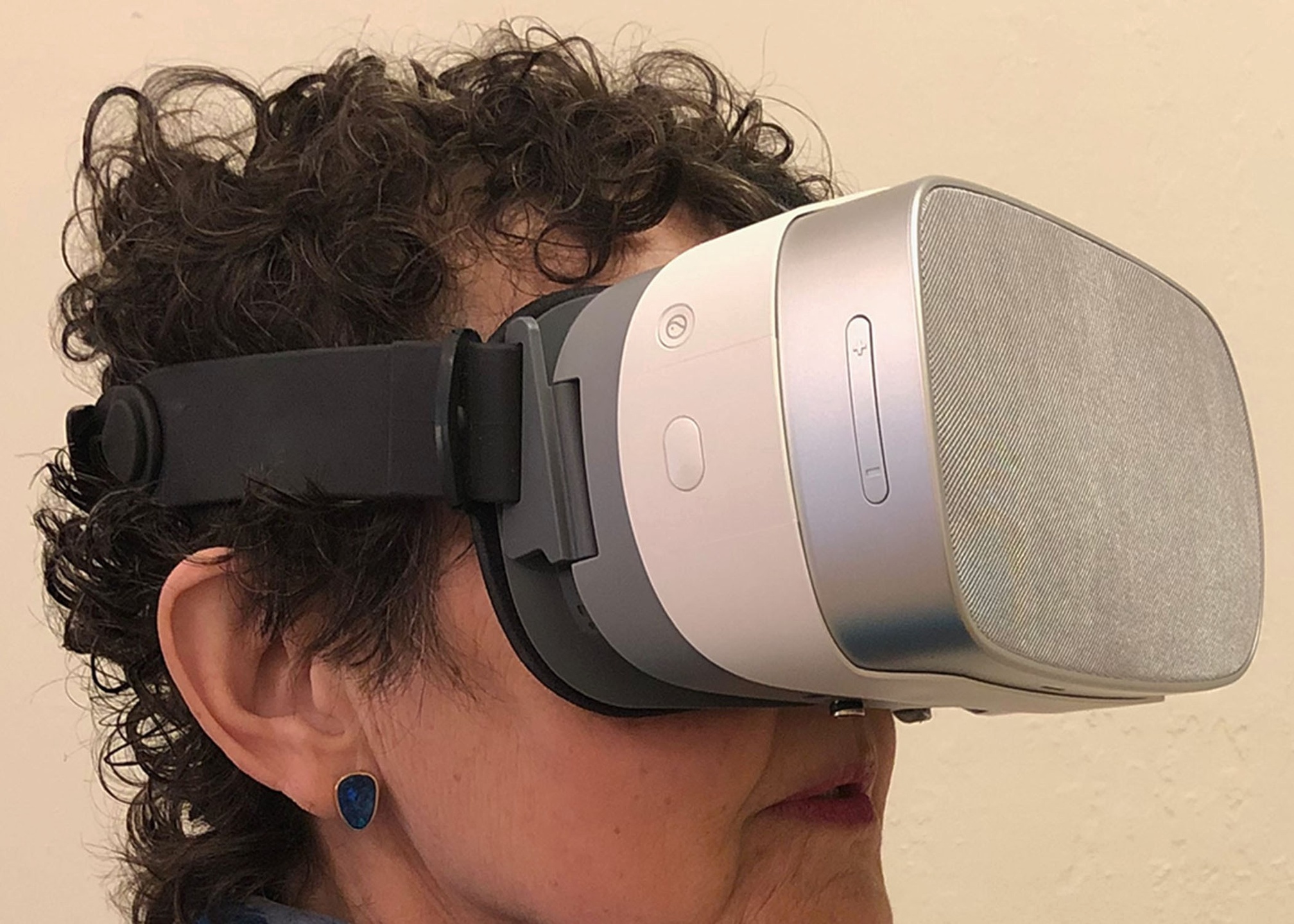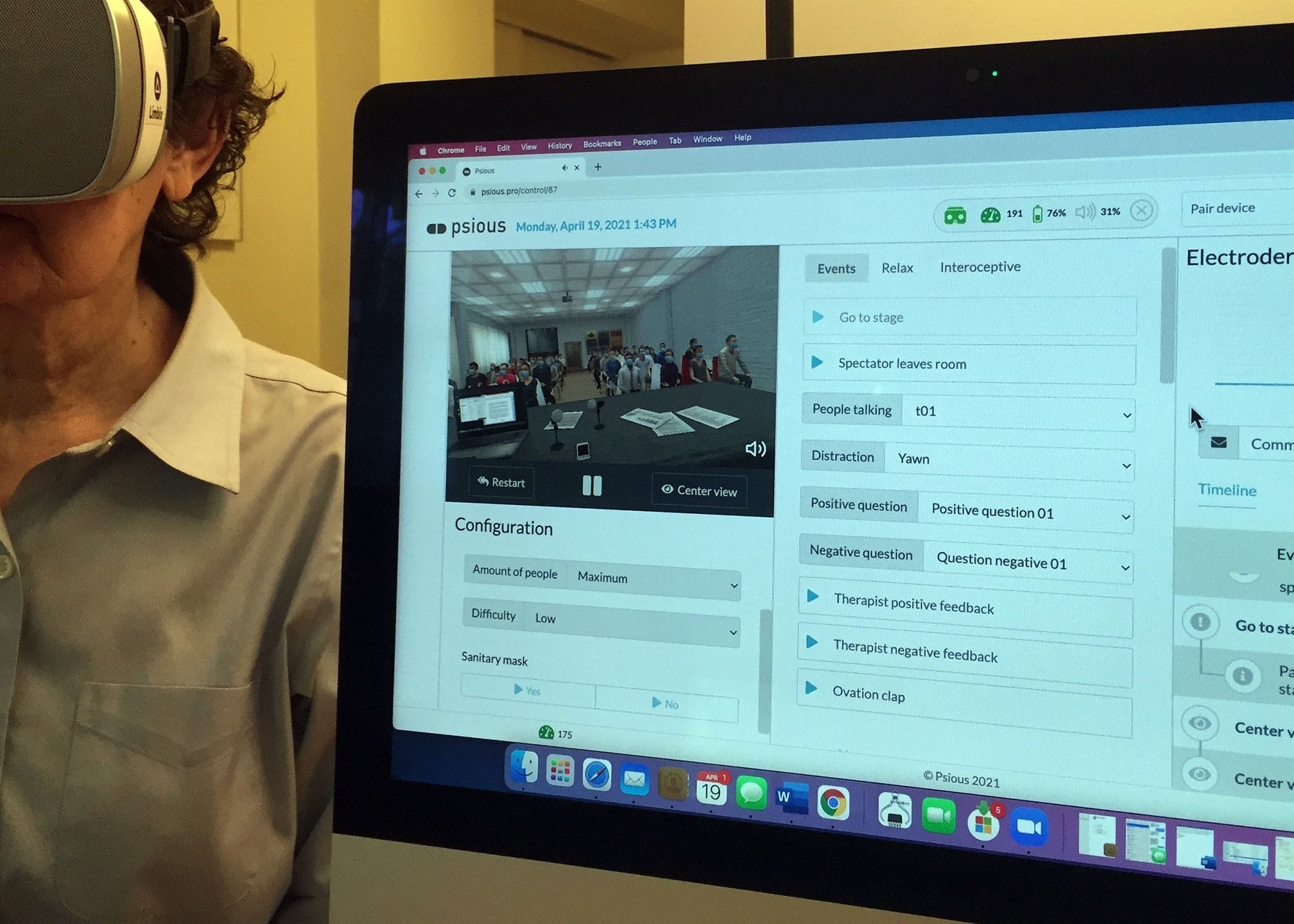VR Psychotherapy Overview
Virtual Reality (VR) is an exciting new tool that a therapist can use in several ways to help increase the effectiveness of psychotherapy for a variety of conditions. Therapists can utilize VR with clients they are treating in-person or remotely via teletherapy, and for client homework.
Benefits of using VR for therapy include:
-
Fast, effective, treatment for many common conditions.
-
New options for providing and controlling exposure therapy.
-
Skills training materials for use in session and for home practice.
-
Additional tools for working with complicated cases.
-
Ability to attract additional clients by offering 'high-tech' specialty treatment.
This tutorial explains the basics of VR usage in therapy including:
-
What is VR therapy?
-
What conditions benefit from VR therapy?
-
How is VR used in therapy?
-
Therapist experience during VR exposure therapy.
-
Which therapeutic approaches use VR?
For more detailed information on how to use VR for therapy see Virtual Reality Therapy for Anxiety: A Guide for Therapists (McMahon, 2022, Routledge.com). Dr. McMahon's book explains multiple therapeutic uses of VR and can benefit therapists who treat a variety of mental health conditions, not just anxiety.
What Is VR Therapy?
VR therapy is psychotherapy that includes client experiences in virtual reality (VR) or augmented reality (AR). VR is a powerful therapeutic tool because it creates immersive, 3-D experiences that evoke physical and emotional responses. AR creates evocative visual experiences by superimposing CGI images onto actual scenes viewed through a smartphone or headset.
Virtual reality uses computer graphics to create an immersive visual environment that the user can view and explore in three dimensions. These computer-generated spaces are called virtual environments (VEs) or virtual worlds.
VR is a tool, not a treatment. Client experiences in VR may be helpful or harmful, like other life experiences.
Virtual experiences provided by products specifically designed for use in therapy (VR Therapy Products) can be controlled by the therapist. These products enable a therapist to provide individualized therapeutic experiences for each client while monitoring the client's responses to each experience.
Typically, the client puts on a VR headset or head-mounted display (HMD) to view and explore a virtual environment. The headset covers the eyes, so all the user sees is the virtual world. As a result, the user feels like they are immersed within this virtual world.
Figure: Example VR Headset

The VR headset tracks the user's head movements and images are adjusted as the user looks around or moves to reflect what a person would see if they were looking around or moving within the virtual space. The user may also have handheld controllers that allow them to interact with virtual objects or to change location within the virtual environment. For more information see the VR Therapy Technology Overview and VR Headsets Buyer's Guide.
Visual immersion in VR may be complemented by appropriate audio, sound effects, or pre-recorded instructions via headphones or speakers in the headset. Controls (such as a steering wheel and pedals for driving), vibrating platforms, scent generators, and other peripheral devices can enhance immersion and a sense of truly being present in the virtual environment. See the VR Peripheral Devices Buyer's Guide.
During therapy, the therapist is not in virtual reality. While using VR therapy products, the therapist can monitor what the client is seeing, and control or change aspects of the client's virtual experience, using the controls provided on a therapist workstation. One example of a therapist workstation is shown in the figure below. For more information, see the VR Therapist Workstation Buyer's Guide.
Figure: Example VR Therapist Workstation

Some VR therapy products can be used during teletherapy sessions, where the client and therapist are in different locations. During teletherapy, therapist and client communicate via a video or audio link, in addition to the VR tools.
Augmented reality uses computer graphics to overlay visual information on a real-life scene viewed though a smartphone camera (similar to Pokémon Go), special glasses, or an AR headset. For example, a user might look at their desk through the camera on their smartphone and see computer generated insects crawling around.
Figure: AR Spider Example (Phobos)

Virtual reality and augmented reality are tools which can be used to enhance therapy in multiple ways. The term 'VR Therapy' is somewhat misleading because the therapist still does the therapy—using VR tools for some aspects of treatment. Depending on the client's needs, VR may be used in most sessions or only during certain phases of treatment.
Some VR therapy products support the use of biofeedback monitoring devices for tracking client physiological responses to different experiences. Biofeedback can also be used as part of therapy, even if the VR therapy product does not support it. See the VR Therapy Biofeedback Devices Buyer's Guide.
Other VR technologies are available but are rarely used for psychotherapy because of cost and space requirements. For example, physically immersive VR spaces (VR caves) and treadmill-like devices that allow a VR user to walk or run while remaining within a confined space.
Which Conditions Benefit from VR Therapy?
Virtual reality can be used as part of treatment for a wide range of psychological conditions and behavioral health issues. The VR Therapy Conditions/Resources Directory provides a list of conditions and issues that may benefit from using VR in therapy with links to VR therapy products that may be useful in treating each condition/issue. Therapists may also find VR to be helpful in treating other conditions that are not on this list or associated with a specific VR therapy product.
Anxiety-Related Conditions for VR Therapy
VR may be helpful for treating multiple anxiety issues including:
-
Anxiety or panic attacks
-
Fears and specific phobias including agoraphobia, blood-injection-injury phobia, claustrophobia (fear of enclosed spaces), driving phobia (vehophobia), flying phobia (aviophobia), height phobia (acrophobia), insect phobias (such as arachnophobia) or animal phobia, etc.
-
Social anxiety including performance anxiety, public speaking anxiety, and test anxiety
-
Generalized anxiety disorder (GAD)
-
Illness anxiety disorder
-
Stress, Tension, and Insomnia
-
Obsessive compulsive disorder (OCD)
-
Post-traumatic stress syndrome (PTSD)
For more information see Virtual Reality Therapy for Anxiety: A Guide for Therapists (McMahon, 2022, Routledge.com).
DSM-5 Headings for Anxiety-Related Conditions
Conditions that may benefit from VR therapy fall under these DSM-5 headings:
-
Anxiety Disorders
-
Specific Phobia
-
Social Anxiety Disorder (Social Phobia)
-
Panic Disorder
-
Panic Attack
-
Agoraphobia
-
Generalized Anxiety Disorder
-
Other Specified Anxiety Disorder
-
Unspecified Anxiety Disorder
-
-
Obsessive-Compulsive and Related Disorders
-
Obsessive-Compulsive Disorder
-
Body Dysmorphic Disorder
-
Other Specified Obsessive-Compulsive and Related Disorder
-
Unspecified Obsessive-Compulsive and Related Disorder
-
-
Trauma- and Stressor-Related Disorders
-
Posttraumatic Stress Disorder (PTSD)
-
Acute Stress Disorder
-
Other Specified Trauma- and Stressor-Related Disorder
-
Unspecified Trauma- and Stressor-Related Disorder
-
-
Somatic Symptom and Related Disorders
-
Illness Anxiety Disorder
-
Other Conditions for VR Therapy
VR therapy is also used to treat the following types of mental health conditions:
-
Addictive disorders or substance-related disorders including alcohol, cigarettes/nicotine, cocaine, gambling, marijuana, shopping, etc.
-
Body dysmorphic disorder or body image issues.
-
Eating disorders.
-
Pain including both acute and chronic pain.
-
Depressive disorders, including using VR to create positive experiences and change self-talk.
VR can be used as part of treatment for neurodevelopmental disorders (autism spectrum disorder (ASD), attention-deficit/hyperactivity disorder (ADHD)) and for cognitive rehabilitation following traumatic brain injury (TBI). However, these uses are not covered in the SVRT Buyer's Guides.
How Is VR Used in Therapy?
Virtual reality can be used for multiple purposes at different steps in the client's treatment plan, as explained below. VR provides additional options for compelling client experiences but using VR does not change the overall treatment plan. VR can be used with many different therapeutic approaches, as discussed below.
Most therapeutic uses of VR follow a pattern where the therapist:
-
Selects a virtual experience for the client from the available content options, based on the client's treatment plan. For more detail on this process see Selecting VR Therapy Content.
-
Prepares the client for the virtual experience. This may include telling the client what is coming and what to do, skills training, therapeutic suggestions, other guidance, checking for issues, etc.
-
Starts and controls the client's virtual environment.
-
Monitors the client's reactions to their virtual experience while providing instruction, encouragement, feedback, or other therapeutic suggestions.
-
Stops the virtual environment when appropriate.
Common uses of VR in therapy include:
-
Diagnosis: VR can be used to help clarify a diagnosis by exposing a client to a virtual environment that mimics a relevant situation while the therapist monitors their reactions. For example, a therapist might check to see if claustrophobia is an issue for a fear-of-flying client by monitoring the client's reactions as they enter a small, enclosed space, such as a virtual elevator.
-
Skills training and practice: VR materials can provide psychoeducation as part of an immersive virtual experience that captures the client's attention and promotes information retention using pre-recorded instructions or instructions given by the therapist. Clients may practice skills like diaphragmatic breathing in a relaxing VE initially and later practice applying these skills while viewing a stress-inducing VE.
-
Exposure therapy: clients can be exposed to stressful activities and situations repeatedly in VR. The therapist can control certain aspects of the client’s virtual experience to tailor the experience to the client’s needs and optimize the therapeutic impact. For example, a client with social anxiety can practice public speaking in VR while the therapist makes the situation more or less stressful by changing the audience size or audience members’ body language and verbal reactions.
-
Reward, relaxation, or reinforcement: pleasurable virtual environments can be used to shape the client’s experience during a session or to end sessions with a positive experience. For example, after exposing a height-phobic client to a stress-inducing elevator VE, the therapist may let the client listen to the waves and relax on a sunny beach in VR.
-
Relapse prevention: help clients deepen learning by practicing their coping skills while experiencing stressful virtual situations. For example, the therapist may have a fear-of-flying client experience in-flight turbulence repeatedly while monitoring the client’s anxiety level and ability to apply the skills learned in therapy.
-
Homework: clients with access to VR tools can be assigned activities to help reinforce the skills they are learning and changes they are making between sessions. For example, a client who fears panic attacks can review the recorded instructions and practice belly-breathing in VR between sessions.
For more information see Virtual Reality Therapy for Anxiety: A Guide for Therapists (McMahon, 2022, Routledge.com).
Note: some VR therapy products support 'other' specialized applications of VR. For example, support for eye movement desensitization and reprocessing (EMDR) therapy includes a virtual environment with specialized visual and auditory stimuli which a client can experience during the appropriate steps in the EMDR treatment.
Keep in mind that VR therapy is still therapy. VR is a tool for making therapy more effective, but virtual reality is not inherently therapeutic. Experiences in VR can be exceptionally real and evocative without being therapeutic.
How Do Therapists Experience VR Exposure?
VR therapy products allow the therapist to control and monitor the client's virtual environment from a VR therapist workstation. The therapist can see what the client is looking at in VR in a 2-D window on their workstation display. Depending on the VR product, the therapist may be able select the virtual environment, start and stop scenarios, and adjust variables that modify certain aspects of the virtual environment or the client's experience.
In some computer-generated VEs, therapists can modify aspects of the environment to tailor experiences to each client’s needs. For example, for a client with fear of driving, the therapist controls might include being able to change the weather, the time of day, the type of road, and the amount of other traffic while the client is driving in the VE. The therapist may also control whether the client is the driver or a passenger, where the client is seated, how many other passengers are in the car, and so on. The therapist can select different environments to have the client drive in the city, on the highway, over a bridge, or through a tunnel.
For a client who gets anxious during job interviews, when speaking up in meetings, or in social settings, the therapist can have the client practice speaking to a group in different settings (table, classroom, auditorium, bar, etc.) and with different numbers of audience members. While the client is speaking to the group, the therapist can control how audience members respond, including verbal feedback or changes in body language.
CGI VEs generally provide options for changing variables and tailoring experiences to specific client needs. Some 3-D videos also allow the therapist to control certain variables. For example, changing the weather or the time of day within a driving VR video.
Some VR products offer pre-recorded instructions that can be played while the client is in the VE. For example, instructions to help clients practice anxiety management skills such as diaphragmatic breathing, progressive muscle relaxation, or mindfulness.
Different VR product offer a range of options. Some VR products let you:
-
Record clients’ reported anxiety levels using a 1-100 (or 0-10) Subjective Units of Distress Scale (SUDS) where 1 (or 0) is no anxiety and 100 (or 10) is extreme anxiety.
-
Automatically record biofeedback sensor measurements, such as galvanic skin response (GSR) data, during therapy. Note: a therapist can use biofeedback during therapy even if the VR product does not support the data collection and correlation.
-
Record which VE is used, start time, changes in VE parameters or variables, and stop time.
-
Consolidate data on VE usage, client SUDS levels, and (optionally) biofeedback readings to create a comprehensive record of what happened during exposure and how the client's reactions changed over time.
-
Print or save session records to give to the client and/or file in their charts.
Which Therapeutic Approaches Use VR?
VR can be used with a wide variety of therapeutic approaches including:
-
Acceptance and Commitment Therapy (ACT): for training skills that foster the acceptance of distress such as diaphragmatic breathing, muscle relaxation, and mindfulness or for practicing acceptance and commitment in VR, even when it is uncomfortable or challenging.
-
Cognitive Behavioral Therapy (CBT): is widely used with VR for exposure therapy as well as for diagnosis, skills training, relaxation/reward, and relapse prevention.
-
Dialectical Behavior Therapy (DBT): virtual environments provide settings in which clients can practice one-mindfully focusing on the present and other DBT skills to improve transfer and generalization to real life settings. You can speak for virtual others while clients practice interpersonal effectiveness skills, e.g., GIVE, DEAR MAN, and FAST.
-
Expressive Arts Therapies: VR art-making tools let clients experiment with brushstrokes, scale, and animation with fewer reality constraints and less cleanup.
-
Eye Movement Desensitization and Reprocessing (EMDR): some VR therapy products include visual or auditory stimuli specifically designed for use during EMDR. VR offers an immediate, vivid way for clients to practice new ways of reacting following EMDR to confirm that desensitization and reprocessing have occurred.
-
Hypnosis/Hypnotherapy: certain VR products create entrancing, changing patterns of color and auditory stimuli that may facilitate entering a hypnotic state, engage client attention, and perhaps enhancing receptivity to hypnotic suggestions. Hypnosis for pain control can be combined with the distraction and absorption of VR.
-
Mindfulness and Mindfulness-Based Therapies: many VR products include mindfulness instructions. Virtual environments can be used to practice mindful awareness coping techniques under increasingly challenging situations to prepare clients for using mindfulness in real life.
-
Music Therapy: VR Applications for music therapy are being explored including VR to help quadriplegics improve breathing, voice, mood, and social connectedness via online group singing and Neurologic Music Therapy (NMT) using VR to help retrain motor function in stroke patients with upper limb hemiparesis.
-
Narrative Therapy: pleasant VR experiences can reinforce clients for attending and doing the work of therapy, while triggering a positive mood which is associated with cognitive flexibility and creative problem-solving. Clients can test out the effects of their changed story in different virtual environments, practice viewing situations in new ways, and prepare to carry their revised story into real world interactions.
-
Positive Psychology: VR can facilitate a range of positive emotions, hopefulness, serenity and peace, or induce feelings of awe. Learning new skills and overcoming fears and problems in VR creates pride and increased confidence. Client may practice being their ‘best self’ in VR interactions.
-
Psychodynamic Therapy: VR can bring outside situations into the office, giving clients an opportunity to apply psychodynamic insights and measure progress. Clients may be more in touch with their emotions when processing affect evoked in-session by a virtual encounter that provides a vivid emotional experience compared to discussing an experience that happened days ago.
-
Relaxation: some VR products include relaxation instructions and pleasant environments, repeatedly entering favorite VEs may help clients relax quickly and deeply. Having clients practice relaxation while virtually confronting stress-inducing situations prepares them to use relaxation when stressed in real life.
-
Schema Therapy or Schema-Focused Therapy: in VR clients can practice changing long-standing dysfunctional patterns of thinking, feeling, and behaving. VR can also be used to teach mindfulness or other affect management skills and help clients self-soothe with relaxing VEs.
-
Solution-Focused Therapy or Solution-Focused Brief Therapy: focuses on helping clients find and implement solutions using interventions like 'the miracle question.' Placing the client within a relevant VE allows the client to not simply imagine and describe what they would do differently if there was a miracle, but to actually demonstrate and practice their new actions repeatedly in VR.
For more information see Virtual Reality Therapy for Anxiety: A Guide for Therapists (McMahon, 2022, Routledge.com).
Next Steps
The next step in learning about VR psychotherapy is the tutorial on Selecting VR Therapy Content.

